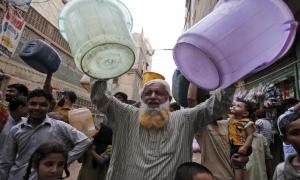By declaring that water and blood can’t flow together, and reviewing the Indus Water Treaty, Indian Prime Minister Narendra Modi has addressed an existential issue of Pakistan.
Of the six mega rivers which originate from Himalayas, India controls the three eastern (Ravi, Baes, Sutlej) and let the western ones (Indus, Chenab and Jhelum) largely reach unimpeded to Pakistan. If the rivers are diverted or silts allowed to dry up its flow, Pakistan would be over. It’s a stronger weapon than any nuclear arsenal or international boycott or harping on repression in Balochistan or Pakistan-occupied Kashmir (PoK) could yield.
Already, Pakistan is as parched as Ethiopia. The Pakistan Council of Research in Water Resources (PCRWR) has warned that the country may run dry by 2025. The report states that the Islamic country first hit the “water stress line” in 1990 and crossed the “water scarcity line” in 2005.
The International Monetary Fund (IMF) states that Pakistan is already the third-most water-stressed country in the world. Its per-capital annual water availability is 1,017 cubic meters, perilously close to the scarcity- threshold of 1,000 cubic meters. It has the world’s fourth highest water usage rate—the amount of water in cubic meters, used per unit of GDP—is the world’s highest. It implies that no country’s economy is more water-intensive than Pakistan’s.
Karachi, home to more than 20 million people, is currently meeting only 50 per cent of its total water requirement, according to officials from the Karachi Water and Sewage Board (KWSB).
The city needs 1.1 billion gallons of water daily but can only supply 550m gallons per day (MGD). Nearly a million newcomers enter the city every year, further stressing the depleting water supply.
Agriculture is the bedrock of Pakistan’s economy. The 2,000-mile long Indus River feeds a vast network of irrigation canals that feed the fields producing wheat, cotton, vegetables—all of which supply the bulk of foreign currency. In the north, hydroelectric power stations are cornerstone of the creaking power system.
This canal water, which is the lifeline for Pakistan’s farmland is hugely underpriced, says the IMF, and thus recovers only one-quarter of annual operating and maintenance costs. Meanwhile agriculture, which consumes almost all annual available surface water is largely untaxed.
So far, India has been more than an ideal neighbour. In the initially years of the two country’s independence, India supplied water free of charge. All these years of wars and acrimony still hasn’t deviated it from the basic tenets of Indus Water Treaty. It has not built reservoirs on rivers that flow into Pakistan.
So dysfunctional is Pakistan that it hasn’t built a single dam in the last 46 years. India has, in contrast, built 4,000 dams with another 150 in the pipeline. In India, about one-third of the water supply is stored in reservoirs compared with just 9 percent in Pakistan.
The water-time bomb is triggering conflicts in the country. Three out of four Pakistani provinces blame the most populous and politically empowered province Punjab for usurping their water sources. The rising rifts in population would only exacerbate the security situation in the country. If things go out of control, a military-takeover just can’t be ruled out, say experts.
Water is already causing jihadist politics in Pakistan. For years, religious conservatives and Islamist militants have accused India of constricting Pakistan’s water supply—without basis one must add.
Hafiz Saeed, the leader of the militant group that carried out the 2008 Mumbai attacks, Lashkar-e-Taiba, regularly accuses India of “water terrorism” in public rallies.
Arshad H. Abbasi, a water and energy expert with the Sustainable Development and Policy Institute of Islamabad, states: “The biggest looming crisis is of governance, not water—which could make Pakistan unlivable in the next few years.”
In Karachi, for instance, the water distribution is hugely unequal: there is no metering system to monitor real use of water waste. A “water tanker mafia” also illegally drills holes in pipelines and “steal” off water to sell it in the black market. Tragically, locals end up buying water at inflated prices which should have reached their home directly anyway.
Population growth and urbanization have led to this grave crisis. Climate change, poor water management and a dysfunctional Pakistan government hasn’t helped.
The water threat which Modi government has held out for Pakistan is the first pro-active action from New Delhi over successive governments. Two things would happen—either Pakistan would fall in line or war would ensue. This could be a deadlier war than any seen between the two countries—and potentially mutually catastrophic. But let it be said, India has been left with no alternative. It’s a price which our and future generations would pay for the follies of Nehru-Indira legacy.


